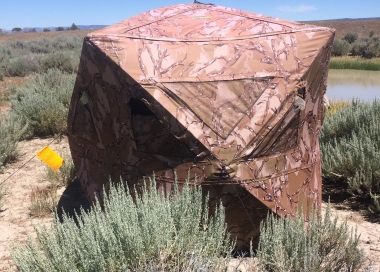
Using big game hunting blinds on federal land
The number of big game hunters using blinds has increased over the last 20 years. Be sure to follow regulations if you plan to use them on federal land.

The increased use of hunting blinds on federal land has resulted in resource damage, more litter, conflicts among hunters and problems for other land users. Problems are particularly bad for pronghorn and archery hunters during drought years as hunters vie for spots near water.
So federal land managers, including the Bureau of Land Management and U.S. Forest Service, want to remind hunters of the rules for using blinds to hunt big game. (Note these policies apply to big game blinds, contact land managers for rules regarding game bird blinds.)
BLM rules for big game hunting blinds
Construction materials
Hunters should consider portable, pop-up blinds -- they're easy, convenient and preferred by land managers.
- All construction materials must be removable. Permanent placement of materials is not allowed.
- Wire mesh is prohibited because it can be hazardous to wildlife and livestock.
- No digging, trenching or other surface disturbance is allowed. Digging pits or depressions exposes bare soil that can lead to soil erosion, allow noxious weeds to establish or disturb cultural or historical artifacts. That said, some reasonable, minor cutting of live vegetation is allowable, such removing a branch obstructing a shooting lane or clearing the area inside the blind. You may also use stakes to anchor your blind.
- Blinds may be constructed of plywood or similar materials but must comply with placement/removal dates (see below).
Placement dates
- Blinds may be placed no earlier than 10 days before the beginning of the hunting season for which the hunter has a valid tag.
- Blinds must be removed within 7 days of the close of that hunting season. Blinds found to be in violation of removal requirements will be removed by BLM staff and disposed of.
Labeling
- The hunter’s full name and zip code should be attached, etched, engraved or painted on the blind. (This helps to ensure that blinds are constructed in compliance, and helps with monitoring and enforcement.)
- Blinds may be used by hunters on a first‐come, first‐ served basis. Under federal regulations, it must be available for use by other hunters. (The placement of a blind on public land does not convey exclusive right of use.) This means that blinds cannot be locked or posted with “no trespassing” signs. Also, blinds must be accessible to law enforcement personnel for inspection. That said, hunters should be respectful of each other’s efforts and give the hunter who set up the blind first claim on the blind when they are hunting.
Water or livestock developments
- Do not divert water or modify water troughs, reservoirs, springs or other developments. Most water sources have legal water rights associated with them, so tampering with their location or flow is illegal. Also, diverting water sources could reduce their benefit to livestock and wildlife.
- Do not harass livestock or impede their access to water sources.
National Forest rules for hunting blinds
The U.S. Forest Service also has rules for use of blinds on national forestland; see below for basic information and contact the forest where you will be hunting for more specifics as policies may vary.
Only portable stands or blinds are allowed on national forestland. Check with your local ranger district for restrictions and time limits; some forests have a short 1-3 day window for how long blinds can be up.
Hunters cannot maintain a structure without authorization, abandon personal property, damage trees (e.g. nailing into trees) or damage other property (e.g. digging) on Forest Service land.
Give wildlife, livestock access to water
Please hunt ethically and give wildlife access to water. Do not camp within 300 feet of a water source to allow livestock and wildlife access to water at night. Also, consider the lingering impact your scent or blind may have on animal use even when you're not there.
Header image by Charlotte Ganskopp


